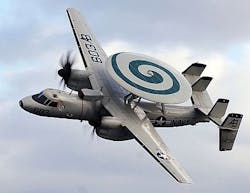Navy researchers tap Rockwell Collins to develop new high-throughput airborne tactical data link technology
ARLINGTON, Va., 17 June 2012. U.S. Navy researchers are looking to military communications experts at Rockwell Collins in Cedar Rapids, Iowa, to investigate design approaches and technologies for a new military tactical data link that offers improved throughput, anti-jam capability, and low probability of intercept.
The Office of Naval Research (ONR) in Arlington, Va., awarded Rockwell Collins a $16.2 million contract earlier this month for the Advanced Tactical Data Link (ATDL) program, which seeks to overcome limitations in existing military data links such as Link-16, the Multifunction Advanced Data Link (MADL) and Cooperative Engagement Capability - Data Distribution System (CEC-DDS). Story continues below
Rockwell Collins data link experts will define and develop an advanced airborne tactical data link that eliminates current throughput and scalability shortfalls such that attack aircraft can shorten engagement kill chains, increase the number of missions per sortie, improve survivability against future coordinated electronic jammers, reduce manpower by automating data linking tasks.
Today's aircraft attack missions need advanced distributed command and control, situational awareness, navigation, and cooperative integrated fire control, Navy researchers point out. These capabilities are necessary to collaborate, coordinate, and rapidly disseminate combat identification, classification, and target assignments among shooters, sensors, and weapons.
To do this, however, Rockwell Collins will develop ATDL technology with increased connectivity and capacity between ground and air forces to make the most of common information concerning command-and-control, intelligence, and targeting. The problem is today's military data links have limited throughput, high latency, as well as insufficient anti-jam and low-probability-of-exploitation capabilities.
Link-16, for example, is the most widely used airborne tactical data link, Navy researchers point out. It provides command and control, situational awareness, weapons coordination, and electronic warfare capabilities, yet does not meet emerging throughput, scalability, and latency requirements -- especially in the midst of electronic attacks.
To fill current needs, Rockwell Collins engineers will develop the ATDL with auto-configuring and self-adapting networking with high data bandwidth and low latency communication for integrated sensing and cooperative integrated fire control.
Rockwell Collins experts will focus on cost-effective jam-resistance, wideband communications, and novel antenna techniques. New technologies eventually may be integrated aboard the Navy E-2D Hawkeye radar surveillance aircraft, the F/A-18G electronic warfare jet, the F-35 fighter-bomber, as well as on unmanned aircraft, ships, and the Joint Tactical Radio System (JTRS).
Rockwell-Collins-developed ATDL technology will be expected to extend the Navy's Cooperative Engagement Capability (CEC) via a new network structure that involves newly developed technology, as well as modifications to existing military data links.
For more information contact Rockwell Collins online at www.rockwellcollins.com, or the Office of Naval Research at www.onr.navy.mil.
Follow Military & Aerospace Electronics and Avionics Intelligence news updates on Twitter

